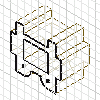
Reference geometry is sketch curves or points created by projecting the model edges, vertices, or work features of another sketch onto the active sketch plane. Reference geometry refers to (is associated with) previously created geometry.
You can use reference geometry in a profile or path sketch or to constrain other sketch geometry. For example, you can use a reference edge as one segment of a profile or as the termination point for other sketch curves.
Methods to create reference geometry
Create reference geometry in two ways:
- When you create a sketch on the planar face of a model, all edges of the face are automatically added to the sketch as reference geometry.
- The Project geometry command projects model edges, vertices, work features, points, or curves from a visible sketch onto the active sketch plane as reference geometry.
Differences in sketched curves and reference geometry
- Sketched curves are not associated with other features unless you specifically add constraints.
- Reference geometry retains its parametric association to the geometry on which it originated throughout all edits.
- Reference geometry can be selected but not edited, so it cannot be used in constrained dragging (for tangency, for example). You can edit sketched curves.
- Reference geometry created by projection can be deleted, but reference geometry automatically inferred when you sketch on a model face cannot be deleted. All sketched curves can be deleted.
Behavior of reference geometry and source feature
Reference geometry updates to reflect changes in its source feature, so that the projection of the geometry onto the sketch plane is correct. For example:
- If edits to a source feature create additional vertices or edges, they are added to the reference geometry.
- Lines that split or merge in the source feature behave as one line in the reference geometry.
- Changes in draft angle or depth of extrusion in the source feature also reposition reference geometry.
- If an edge of a source feature is trimmed, the sketch that refers to that edge resizes to the new length.
- If reference geometry is based on a feature that is then deleted, the reference geometry loses its association to the original feature and is converted to fixed sketch curves. Constraints and dimensions are preserved.